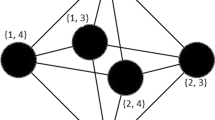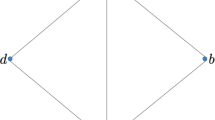Abstract
A relative t-design in the binary Hamming association schemes H(n, 2) is equivalent to a weighted regular t-wise balanced design, i.e., certain combinatorial t-design which allows different sizes of blocks and a weight function on blocks. In this paper, we study relative t-designs in H(n, 2), putting emphasis on Fisher type inequalities and the existence of tight relative t-designs. We mostly consider relative t-designs on two shells. We prove that if the weight function is constant on each shell of a relative t-design on two shells then the subset in each shell must be a combinatorial \((t-1)\)-design. This is a generalization of the result of Kageyama who proved this under the stronger assumption that the weight function is constant on the whole block set. Using this, we define tight relative t-designs for odd t, and a strong restriction on the possible parameters of tight relative t-designs in H(n, 2). We obtain a new family of such tight relative t-designs, which were unnoticed before. We will give a list of feasible parameters of such relative 3-designs with \(n \le 100\), and then we discuss the existence and/or the non-existence of such tight relative 3-designs. We also discuss feasible parameters of tight relative 4-designs on two shells in H(n, 2) with \(n \le 50\). In this study we come up with the connection on the topics of classical design theory, such as symmetric 2-designs (in particular 2-\((4u-1,2u-1,u-1)\) Hadamard designs) and Driessen’s result on the non-existence of certain 3-designs. We believe Problems 1 and 2 presented in Sect. 5.2 open a new way to study relative t-designs in H(n, 2). We conclude our paper listing several open problems.
Similar content being viewed by others
References
Bannai E.: On tight designs. Quart. J. Math. 28, 433–448 (1977).
Bannai E., Bannai E.: Remarks on the concepts of \(t\)-designs. J. Appl. Math. Comput. 40(1-2), 195–207 (2012) (Proceedings of AGC 2010).
Bannai E., Ito T.: Algebraic Combinatorics I: Association Schemes. Benjamin/Cummings, Menlo Park (1984).
Bannai E., Bannai E., Bannai H.: On the existence of tight relative 2-designs on binary Hamming association schemes. Discret. Math. 314, 17–37 (2014).
Bannai E., Bannai E., Suda S., Tanaka H.: On relative t-designs in polynomial association schemes. Electron. J. Comb. 22, \(\sharp \)P4.47 (2015). arXiv:1303.7163S.
Bannai E., Bannai E., Zhu Y.: A survey on tight Euclidean \(t\)-designs and tight relative \(t\)-designs in certain association schemes. Dedicated to Nikolai Dolbilin on the occasion of his 70th birthday. Proc. Steklov Inst. Math. 288, 189–202 (2015).
Beth T., Jungnickel D., Lenz H.: Design Theory, 2nd edn. Cambridge University Press, New York (1999).
Brouwer A.E., Cohen A.M., Neumaier A.: Distance-Regular Graphs. Springer, New York (1989).
Chen Z., Zhao D.: On symmetric BIBDs with same 3-subset multiplicity (submitted).
Colbourn C.J., Dinitz J.H.: Handbook of Combinatorial Designs, 2nd edn. Chapman and Hall/CRC, London (2007).
Delsarte P.: An algebraic approach to the association schemes of the coding theory. Thesis, Universite Catholique de Louvain (1973) Philips Res. Repts Suppl. 10 (1973).
Delsarte P.: Pairs of vectors in the space of an association scheme. Philips Res. Rep. 32, 373–411 (1977).
Delsarte P., Seidel J.J.: Fisher type inequalities for Euclidean \(t\)-designs. Linear Algebra Appl. 114–115, 213–230 (1989).
Denniston R.H.F.: Enumeration of symmetric designs (25,9,3). North Holland Math. Stud. 65, 111–127 (1982).
Driessen L.H.M.E.: \(t\)-Designs, \(t\ge 3\). Technical Report, Department of Mathematics, Eindhoven University of Technology, Holland (1978).
Dukes P., Short-Gershman J.: Nonexistence results for tight block designs. J. Algebr. Comb. 38, 103–119 (2013).
Enomoto H., Ito N., Noda R.: Tight 4-designs. Osaka J. Math. 16, 39–43 (1979).
Kageyama S.: A property of \(T\)-wise balanced designs. ARS Comb. 31, 237–238 (1991).
Kharaghani H., Tayfeh-Rezaie B.: Hadamard matrices of order 32. J. Comb. Des. 21, 212–221 (2013).
Kramer E.S., Kreher D.L.: \(t\)-Wise balanced designs. In: Coulbourn C.J., Dinitz J.H. (eds.) Handbook of Combinatorial Designs, Chap. VI 63, 2nd edn, p. 657. Chapman Hall/CRC, Boca Raton (2007).
Li Z., Bannai E., Bannai E: Tight relative \(2\)- and \(4\)-designs on binary Hamming association schemes. Graphs Comb. 30, 203–227 (2014).
Peterson C.: On tight \(6\)-designs. Osaka J. Math. 14, 417–435 (1977).
Home Page of Ted Spence. http://www.maths.gla.ac.uk/~es/.
Spence E.: A complete classification of symmetric \((31, 10, 3)\) designs. Des. Codes Cryptogr. 2, 127–136 (1992).
Xiang Z.: Non-existence on non-trivial tight \(8\)-designs (preprint) (Jan, 2015).
Zhu Y., Bannai E., Bannai E.: Tight relative \(2\)-designs on two shells in Johnson association schemes. Discret. Math. 339(2), 957–973 (2016).
Acknowledgments
We are very grateful to many people for their help in completing this work. We thank Andries Brouwer and Akihiro Munemasa for their help for us to understand Driessen’s work on certain 3-designs. In particular, Andries Brouwer kindly sent us the Ph.D. thesis of Driessen [15]. We are very grateful to Ted Spence for sending us the incidence matrices of all the 1106 number of 2-(23, 11, 5) designs and all the 151 number of 2-(31, 10, 3) designs, which were very useful in our considerations of these cases. We also very much benefited from the information presented in his home page. We are very thankful to Akihide Hanaki and Hadi Kharaghani answering our questions on 2-(31, 15, 7) designs. We are extremely grateful for Brendan McKay for showing us how to obtain all 2-(31, 15, 7) designs from the list of all Hadamard matrices of order 32 by Kharaghani and Tayfeh-Rezaie. Moreover, Brendan McKay kindly determined all the \(\lambda _3\)-sequences with length at most 4, among all the 2-(31, 15, 7) designs for us. They were extremely useful for our research presented in this paper. We also thank Zongchen Chen and Da Zhao, undergraduate students of Shanghai Jiao Tong University. They made a decisive contribution to the problem presented in this paper. Their results will be published independently, but we included the explanation of some of their results in this paper. The first author (Eiichi Bannai) is supported in part by NSFC Grant No. 11271257.
Author information
Authors and Affiliations
Corresponding author
Additional information
Dedicated to Andries Brouwer on the occasion of his 65th birthday.
This is one of several papers published in Designs, Codes and Cryptography comprising the special issue in honor of Andries Brouwer’s 65th birthday.
Rights and permissions
About this article
Cite this article
Bannai, E., Bannai, E. & Zhu, Y. Relative t-designs in binary Hamming association scheme H(n, 2). Des. Codes Cryptogr. 84, 23–53 (2017). https://doi.org/10.1007/s10623-016-0200-0
Received:
Revised:
Accepted:
Published:
Issue Date:
DOI: https://doi.org/10.1007/s10623-016-0200-0
Keywords
- Relative t-design
- Tight design
- Regular t-wise balanced design
- Hamming association scheme
- Hadamard design




